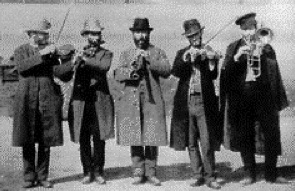
04/25/2011
Yom Ha Shoah, also known as Holocaust Remembrance Day, will be observed with a musical memorial event on Sunday, May 1, at SUNY Cortland.
A brief remembrance service to mark the memory of those lost in the Holocaust will begin at 6 p.m. in Brockway Hall, Jacobus Lounge. As part of the program, a performance of the traditional music of Eastern European Jewry, called klezmer, will be presented by musicians from the Mitzfits, an Ithaca-based klezmer band. Sponsored by the Campus Artist and Lecture Series, Hillel, the Jewish Studies Committee and the Project on Eastern and Central Europe, the event is free and open to the public.
The musicians participating in Sunday’s program are:
• Bob Alexander. He has played piano accordion for 30 years, with a focus on klezmer and other Jewish music for the past 10 years.
• Rima Grunes. A classically trained violinist who performed as a child at The Eastman Theatre, SUNY Buffalo and Carnegie Hall, she began to play again in the spring of 2004, inspired by the arrival in Ithaca of world-renowned klezmer clarinetist Joel Rubin.
 |
| The Mitzfits, an Ithaca, N.Y., based klezmer band, performs their current interpretation of the traditional, Eastern European music style recently. |
• Ryan Zawel. He is the music director of the Elizabeth Ann Clune Montessori School of Ithaca, a member of the Joel Rubin Jewish Music Ensemble and of the Temple Rockers. A trombonist, Zawel has served as both lecturer of trombone and director of the Klezmer Ensemble at Ithaca College. He has performed with the Syracuse Symphony, the Tommy Dorsey Orchestra, Broadway’s Miss Saigon, and has toured Poland with Infinity Quartet, a collective of experimental musicians. In 2004, he was a featured soloist at the International Trombone Festival.
Klezmer was originally the ritual and celebratory music of the Yiddish-speaking Jews of Eastern Europe, where it developed over the course of many centuries, according to Linda Lavine, an associate professor of psychology and the program’s organizer.
The modern klezmer tradition was brought to North America with the Jewish immigration wave from Russia and other Eastern European countries between 1881 and 1924, Lavine noted. The recent popularity of the music has brought it far from its roots in medieval minstrelsy and Jewish ritual and into the sphere of mainstream culture. It has inspired parallel developments in jazz and improvised music, such as the Radical Jewish Culture movement in New York’s downtown scene, as well as spawning a new genre of klezmer-influenced art music compositions.
For more information, contact Lavine.